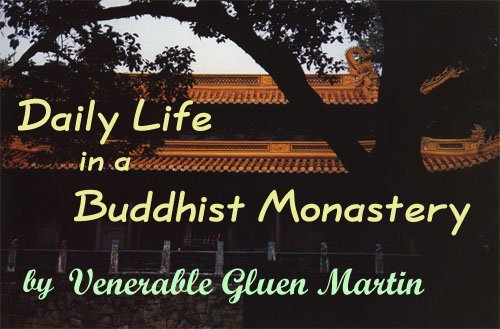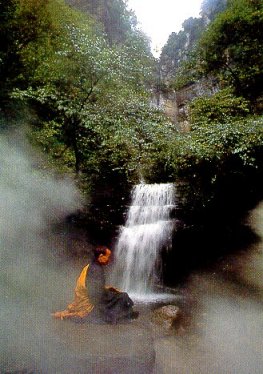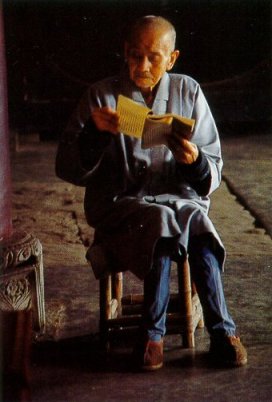|
In Buddhism, traditionally, there are monasteries established for religious practice. One of the first monasteries, founded after the enlightenment of Shakyamuni Buddha was named Jetavana-Vihara. Jetavana Vihara was located in Central India. It was established through the support of a merchant called Sudatta. During the rainy season people would gather in the monastery in order to practise the Buddhist Way. This was the beginning of the Buddhist training period. Three or more people assembling for the purpose of practising the Buddhist Way became known as the Samgha (Sangha). The four groups, monks, nuns, laywomen, and laymen would practise the Way. The word for the training period from Sanskrit is Varsika. The Chinese characters for the training period have the meaning of peaceful (quiet, contentedly), living. In the Buddhist monasteries, upon waking in the morning, usually, there is first a period of sitting meditation. Sitting meditation is the fundamental practice of Buddhism. It originates from Shakyamuni Buddha, seeing the morning star and attaining enlightenment while sitting in meditation. This fundamental practice of Buddhism has been transmitted for over 2,500 years to the present day due to the great compassion and constant practice of the successive Buddhas and Patriarchs.
Morning Service may be followed by temple cleaning. Sweeping and wiping inside the temple. And perhaps sweeping the gardens and grounds outside also. The temple is cleaned daily. Then all the people will take their breakfast together. Breakfast is a simple meal, sometime after breakfast there is a morning work period. Each day there are various tasks and duties which should be performed. Splitting wood, pulling weeds, cooking food, and maintenance of the buildings are some of the jobs which are done. Some people may have received the impression that people living in monasteries do not work, or that perhaps there is a lack of activity. However, where the Buddha Dharma in flourishing, the people practising are diligent in their daily lives. In monasteries where there is the teaching, practice, and enlightenment of the Buddhist Way, the people are diligent and active in body and mind. Concerning this, there is the saying of Master Huai-Hai (720 A.D.-814 A.D.) who taught, 'A day of no working is a day of no eating.' This is a standard for monasteries where the Buddhist Way is truly practised. 'A day of no working is a day of no eating.' After the morning work period is finished, lunch will be served. Then there will be an afternoon work period. Generally, the work in the afternoon will be similar to the morning. Various tasks and duties will be performed by all the people. At the end of the afternoon work period, there will be an evening service where the sutras will again be recited. The sutra reading may be followed by a simple evening meal. Then there will be time for a shower or a bath.
It is hoped that sentient beings may widely be saved, or widely receive the benefits of the Buddhist Way. For this reason, people who live and work in society may also be permitted to join the monastic practice for various lengths of time when it is possible. Laymen and laywomen who wish to study and practise the Buddhist Way may also participate in the daily religious practice of the monastery. It is important to understand that Buddhism is not something special. Some people may see unfamiliar Buddhist statues and images, and come to believe that Buddhism is something special. However, the etymology of the word Buddha, from the Sanskrit word "Budh", means to know or to understand. That is to know or to understand one’s self. Buddhism is a matter of knowing, or getting a hold of one’s self in the present. The study of Buddhism is the study of self. It is not something special or unusual. Practising in a monastery, making efforts in the sangha (the Buddhist community), it is possible to know oneself, and to know the Buddhist Way. Relying on (or taking refuge in), the Buddha, the Dharma, and the Sangha, surely it is possible to clarify oneself and the Buddhist Way. And we can be liberated from the four sufferings and the eight sufferings. The Buddhist Way is called the supreme Way. |


 Following
the period of sitting meditation in the early morning is the morning
service. During the morning service the sutras, the Buddhist teaching
are recited by all. Various sutras are recited. Sutras from the Original
Teacher Shakyamuni Buddha, and teachings from various Patriarchs of
the Buddhist Way.
Following
the period of sitting meditation in the early morning is the morning
service. During the morning service the sutras, the Buddhist teaching
are recited by all. Various sutras are recited. Sutras from the Original
Teacher Shakyamuni Buddha, and teachings from various Patriarchs of
the Buddhist Way. In
the evening there is again sitting meditation. During the meditation
period, there may be an opportunity for an interview with the Abbot
or Abbess, to speak about religious practice. This is also an important
part of Buddhist practice. Studying with a teacher, and questioning
the Dharma. This is a time to raise questions concerning daily practice
and the Buddha Dharma. Due to this tradition, the Eye and Treasury of
the True Dharma has been transmitted for over 2,500 years. Following
evening meditation, the people practising in the monastery may go to
sleep. This is a general outline of Buddhist practice in a monastery.
In
the evening there is again sitting meditation. During the meditation
period, there may be an opportunity for an interview with the Abbot
or Abbess, to speak about religious practice. This is also an important
part of Buddhist practice. Studying with a teacher, and questioning
the Dharma. This is a time to raise questions concerning daily practice
and the Buddha Dharma. Due to this tradition, the Eye and Treasury of
the True Dharma has been transmitted for over 2,500 years. Following
evening meditation, the people practising in the monastery may go to
sleep. This is a general outline of Buddhist practice in a monastery.